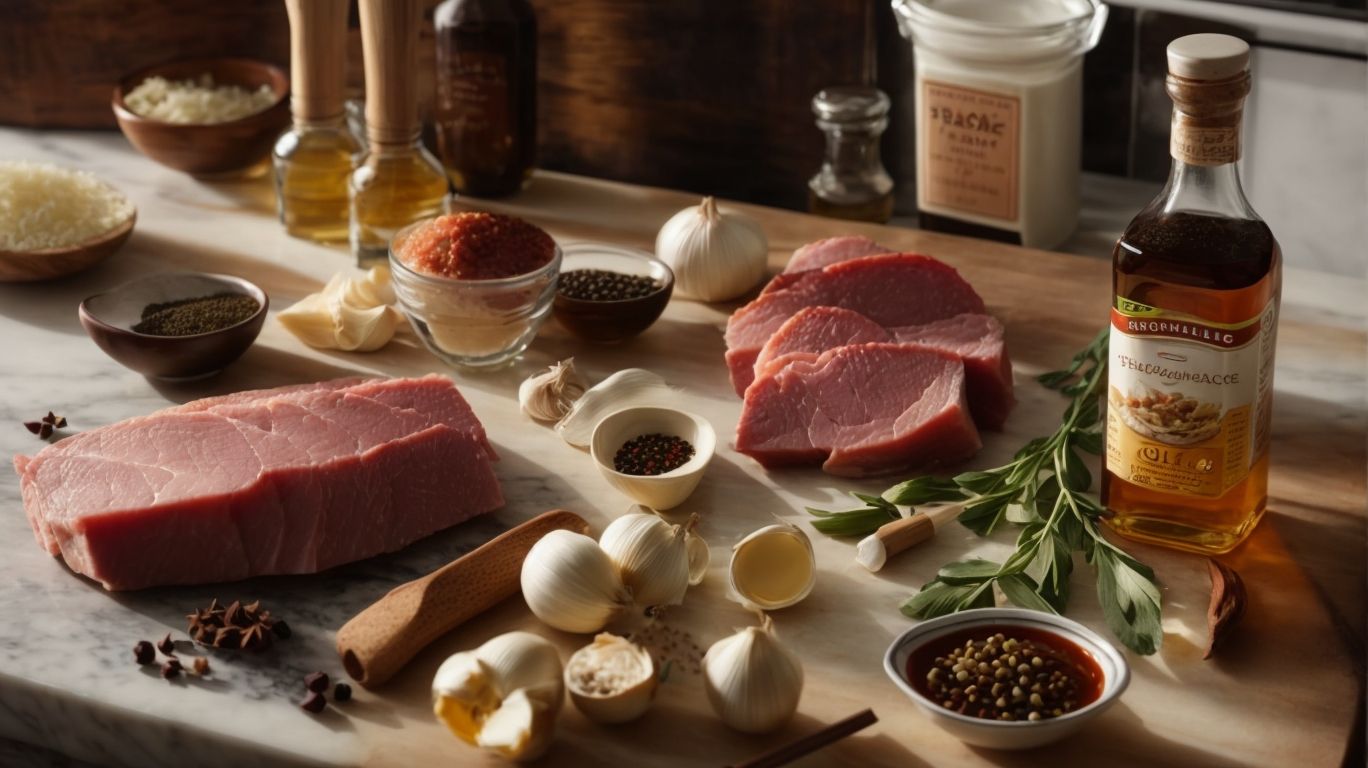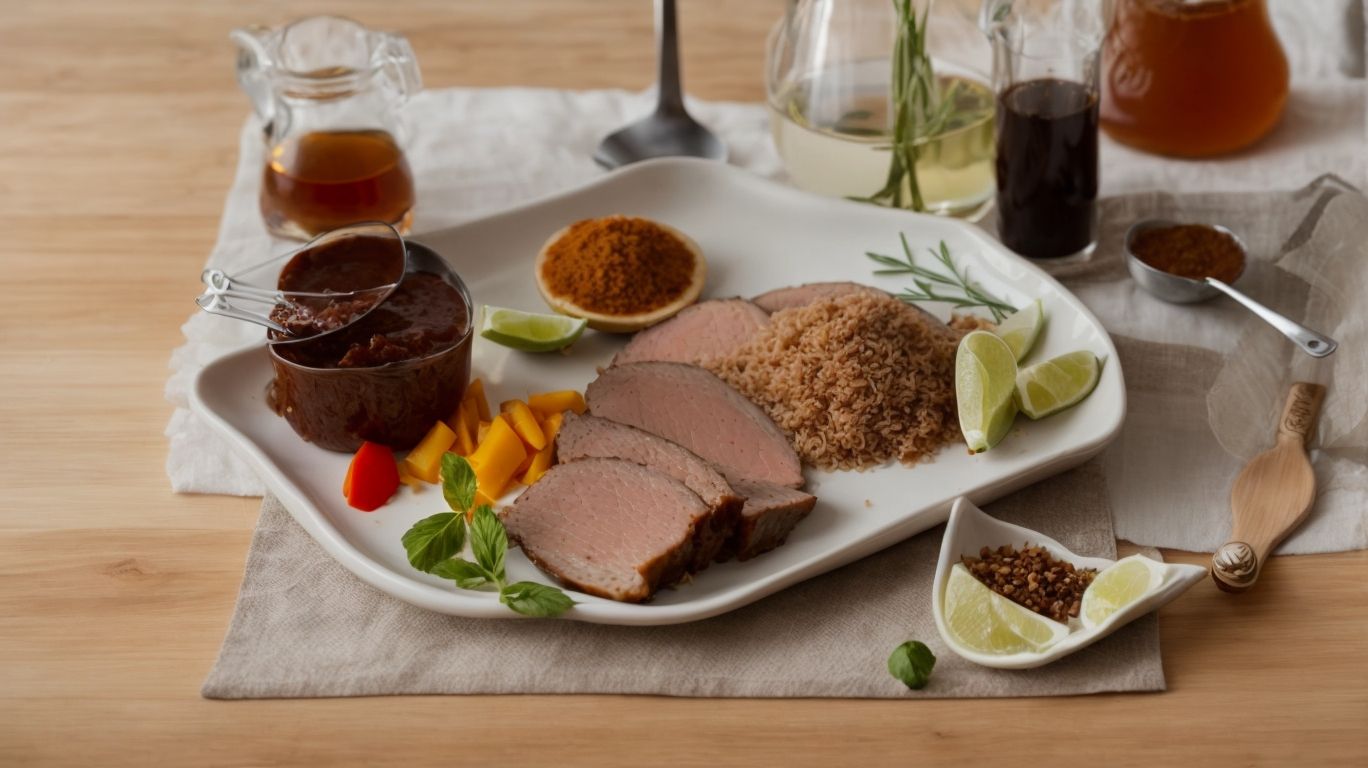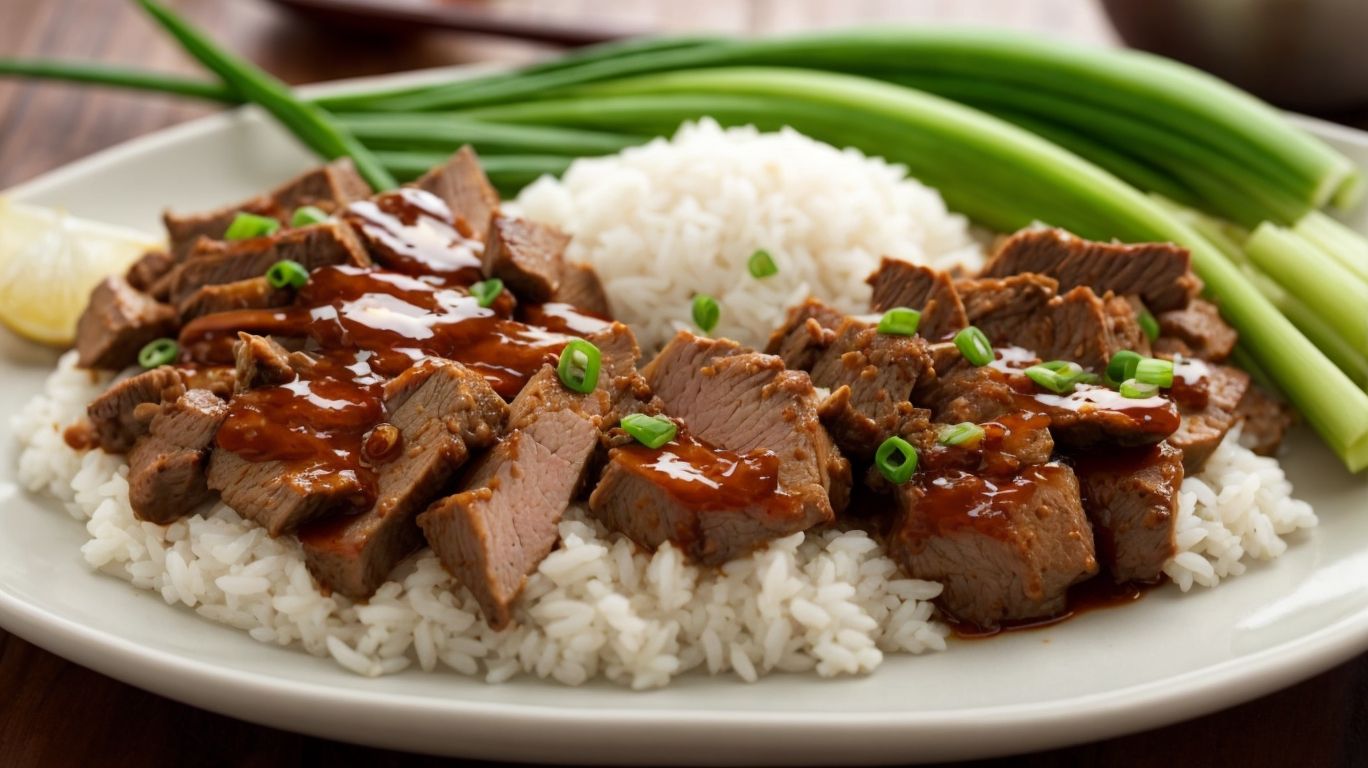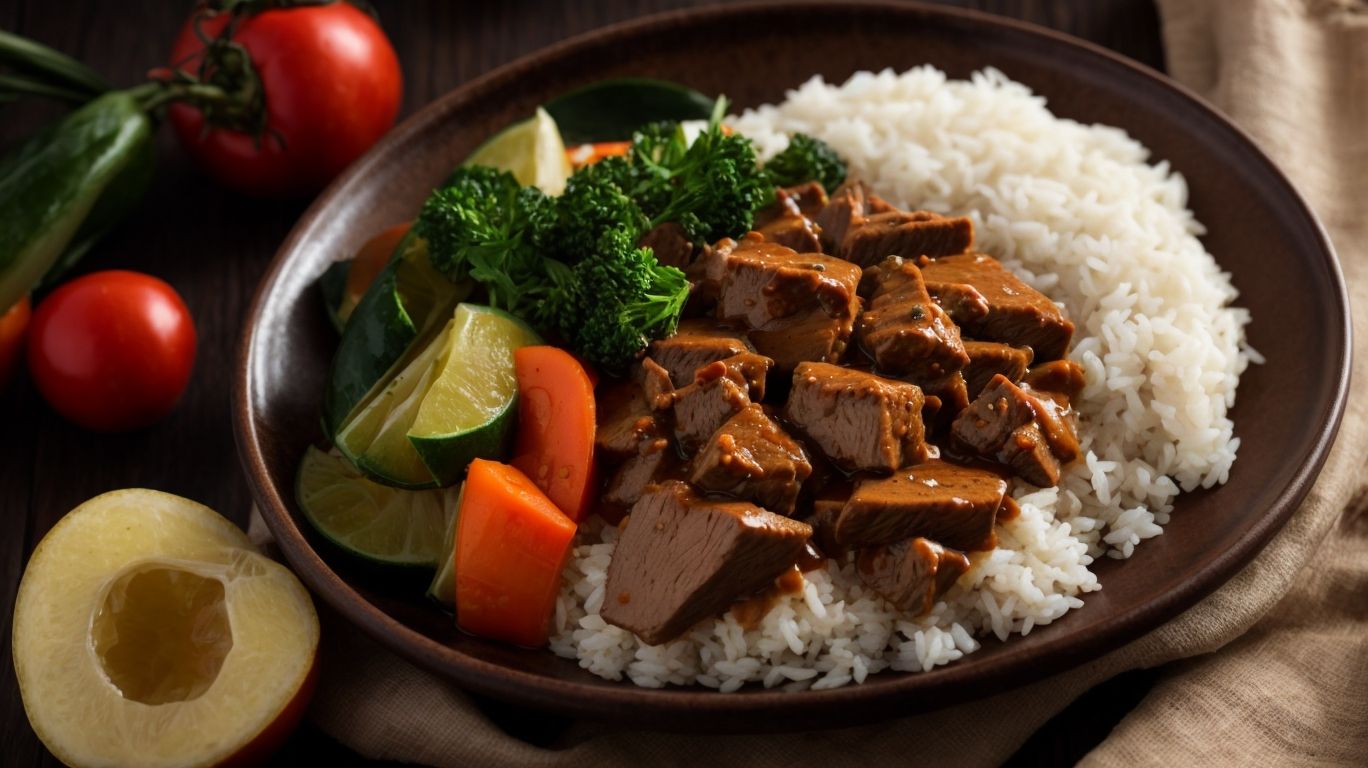How to Cook Pork Adobo Step by Step?
Looking to impress your family or guests with a delicious Filipino dish? Look no further than Pork Adobo.
This article will guide you through the process of cooking Pork Adobo step by step. From marinating the pork to adding the finishing touches, all the tips and tricks you need to make the perfect Pork Adobo will be shared.
So, grab your apron and get ready to create a mouthwatering dish that will leave everyone wanting more.
Key Takeaways:
Ingredients for Pork Adobo

Credits: Poormet.Com – Bobby Thomas
Creating a delicious Pork Adobo dish requires a selection of key ingredients that include pork belly, soy sauce, vinegar, garlic, and aromatic bay leaves among other essential elements.
Each ingredient plays a crucial role in imparting distinctive flavors to this Filipino classic. The succulent pork belly provides a rich and indulgent taste, while the soy sauce adds depth and a savory umami touch.
Vinegar introduces a sharp tanginess, balancing the dish’s richness perfectly. The pungent garlic infuses a robust aroma, enhancing the overall taste profile.
Aromatic bay leaves lend a subtle earthy note, complementing the other flavors harmoniously.
Experimenting with variations like adding coconut milk for a creamy twist or incorporating pineapple chunks for a sweet-sour contrast can elevate your Pork Adobo to new heights of culinary delight.
What Type of Pork is Best for Adobo?
When preparing Pork Adobo, the ideal choice of pork would be succulent pork belly, known for its tender texture and ability to absorb the rich flavors of the marinade and sauce.
Selected for its perfect balance of lean meat and luscious fat, pork belly is a versatile cut that becomes melt-in-your-mouth tender when cooked low and slow. The layers of fat in pork belly self-baste the meat, ensuring a moist and flavorful result that’s perfect for the slow simmering process of Pork Adobo. The marbling in pork belly enhances the dish with a delicious richness, making it a go-to choice for those seeking a decadent and indulgent culinary experience.
What Other Ingredients are Needed for Adobo?
Apart from the pork itself, Pork Adobo requires essential ingredients such as soy sauce, vinegar, garlic, bay leaves, peppercorns, and water to create its signature savory and tangy flavor profile.
These additional ingredients play crucial roles in enhancing the depth of flavors in the dish. Soy sauce provides the salty umami base, while the vinegar adds the perfect touch of acidity, balancing the richness of the pork.
The garlic infuses a robust aroma and taste, complemented by the aromatic notes from the bay leaves, creating layers of complexity in each bite.
Peppercorns bring a subtle hint of heat and earthiness, adding a delightful contrast to the savory-sour theme.
For those looking to personalize the recipe, consider experimenting with different types of vinegar like cane or apple cider, or even adding a touch of sweetness with honey or coconut sugar.
Step-by-Step Guide to Cooking Pork Adobo

Credits: Poormet.Com – Logan Walker
Master the art of cooking Pork Adobo with this comprehensive step-by-step guide that covers marinating the pork, preparing the sauce, simmering to perfection, and infusing rich flavors.
Start by marinating bite-sized pork cuts in a mixture of soy sauce, vinegar, crushed garlic, and black peppercorns. Allow the meat to absorb the flavors for at least 30 minutes, ensuring a more flavorful outcome.
Next, gently sauté the marinated pork in a hot pan until lightly browned, enhancing its texture and taste. While the pork is cooking, combine soy sauce, vinegar, bay leaves, and a touch of coconut milk in a separate pot to prepare the rich and tangy sauce for the dish. Let the mixture simmer until it thickens slightly, adding a creamy depth to the classic Filipino dish.
To complete the cooking process, add the browned pork to the sauce and let it simmer gently until the meat is tender and infused with all the delicious flavors. Serve your Pork Adobo hot over steamed rice for a satisfying and flavorful meal.
Step 1: Marinating the Pork
The initial step in preparing Pork Adobo involves marinating the pork pieces in a mixture of soy sauce, vinegar, garlic, and other seasonings to enhance the meat’s flavor and tenderness.
Marination is a crucial stage in the cooking process as it allows the flavors to infuse deeply into the meat, resulting in a more flavorful and succulent dish. For Pork Adobo, it is recommended to marinate the pork for at least 1-3 hours, or ideally overnight, in the refrigerator for maximum absorption of the marinade. Refrigeration also helps in tenderizing the meat, making it juicier when cooked.
During the marination process, the combination of soy sauce and vinegar acts as a powerful duo, tenderizing the pork while adding a savory and tangy kick to the dish. The addition of garlic and other seasonings further enhances the complexity of flavors in the marinade, creating a harmonious blend that elevates the taste of the Pork Adobo.
Step 2: Preparing the Sauce
Creating the flavorful sauce for Pork Adobo involves simmering a blend of soy sauce, vinegar, garlic, bay leaves, and peppercorns to infuse the dish with its characteristic savory and tangy taste.
Simmering is a crucial step in the process, as it allows the ingredients to meld together, amplifying the umami flavors of soy sauce and the sharpness of vinegar. To enhance the complexity of the sauce, some variations include adding a touch of sweetness with brown sugar or a hint of heat with chili peppers. Experimenting with different ratios of ingredients can tailor the sauce to your personal preference, be it a more tangy or sweeter profile.
Step 3: Searing the Pork
To enhance the texture and flavor of the pork, sear the marinated pieces in a hot pan before adding them to the simmering sauce, creating a caramelized exterior and locking in succulence.
Searing plays a vital role in cooking Pork Adobo as it not only intensifies the taste but also contributes to the improved texture of the meat. When the pork pieces hit the hot pan, a Maillard reaction occurs, resulting in the beautiful browning that enhances the overall dish’s visual appeal. This reaction is a chemical process that creates aromatic compounds and deepens flavors, transforming the pork into a more complex and delicious ingredient.
Step 4: Simmering the Adobo
Allow the marinated pork to simmer gently in the flavorful sauce until tender, absorbing the delicious aromas of garlic, bay leaves, and peppercorns, with an option to add coconut milk for a creamy twist.
During this traditional simmering process, the pork becomes incredibly succulent as it slowly cooks, allowing the flavors to meld together harmoniously. The key here is patience – the longer the simmer, the more the flavors intensify. Many households swear by simmering their Pork Adobo for hours, letting the meat tenderize and absorb all the savory goodness of the sauce.
For a variation that adds a luxurious level of richness, consider introducing coconut milk to the simmering pot. This addition not only brings a creamy texture but also imparts a subtle sweetness that perfectly complements the savory components of the dish.
Step 5: Adding the Potatoes
For a hearty touch, consider adding potatoes to the simmering Pork Adobo, allowing them to soak up the savory sauce and complement the tender pork with their earthy flavor and satisfying texture.
Not only do potatoes add a fulfilling element to the dish, but they also contribute to its overall heartiness and make it a comforting meal option. Their starchiness helps to thicken the sauce, creating a rich and flavorful consistency that coats the meat beautifully.
If you’re looking to enhance the nutritional value of your Pork Adobo, consider incorporating other vegetables such as carrots, bell peppers, or green peas. These additions not only introduce a variety of flavors but also bring a colorful and vibrant appeal to the dish.
Step 6: Finishing Touches
As a final step, adjust the seasoning of the Pork Adobo to taste, garnish with fresh herbs or a drizzle of coconut milk for added richness, and serve the dish hot with steamed rice for a complete meal experience.
After adjusting the seasoning, you can further enhance the presentation by sprinkling some freshly chopped cilantro or parsley over the Pork Adobo. The vibrant green colors and aromatic flavors will complement the rich savory taste of the dish.
For a touch of acidity, consider adding a squeeze of fresh lime juice before serving. The brightness of the citrus will cut through the richness of the adobo sauce, balancing the flavors beautifully.
When serving, arrange the Pork Adobo neatly on a platter, garnishing with a few whole sprigs of herbs for an inviting visual appeal. Pair it with warm steamed rice in a decorative serving dish to elevate the overall look of the meal.
Tips and Tricks for Perfect Pork Adobo

Credits: Poormet.Com – Jack Garcia
Achieve culinary excellence with these expert tips and tricks for preparing the perfect Pork Adobo, from adjusting flavors to making the meat more tender for a delightful dining experience.
One key element in enhancing the flavors of Pork Adobo is the marinade. To infuse the meat with depth and richness, consider marinating the pork overnight in a mixture of soy sauce, vinegar, garlic, bay leaves, and black peppercorns. This allows the flavors to penetrate the meat thoroughly, resulting in a more flavorful dish.
To ensure the pork is tender and succulent, try using a multi-cooking method. After simmering the meat in the marinade on the stove, transfer it to the oven and bake at a low temperature. This slow cooking process helps break down the fibers in the meat, leading to a more tender texture.
For a creative twist on traditional Pork Adobo, consider adding a touch of sweetness with pineapple chunks or a hint of heat with chopped chili peppers. These variations can add a unique dimension to the dish and cater to different taste preferences.
How to Adjust the Flavor of Adobo?
Fine-tune the flavor profile of Pork Adobo by experimenting with additional seasonings like MSG, extra soy sauce, or a dash of sriracha to achieve the desired balance of savory, salty, and spicy notes.
In terms of enhancing the taste of Pork Adobo, the possibilities are endless. Consider adding aromatic bay leaves and tangy vinegar for a traditional touch, or mixing in a bit of honey for a hint of sweetness. For those who prefer a smokier flavor, a touch of smoked paprika can work wonders. To elevate the dish further, try incorporating fresh herbs like rosemary or thyme for a fragrant twist. Customizing your Pork Adobo opens up a world of culinary creativity, where each adjustment can lead to a unique and delicious variation.
How to Make Adobo More Tender?
Enhance the tenderness of the pork in Adobo by extending the marination period, opting for slow cooking techniques, or adding tenderizing ingredients like vinegar or coconut milk to achieve a melt-in-your-mouth texture.
One effective method to tenderize pork for Adobo further is by incorporating acidic ingredients such as vinegar in the marinade. Vinegar helps break down the meat fibers, resulting in a softer texture. Consider the option of braising the pork in a flavorful broth at a low temperature for an extended period to ensure the meat becomes tender and juicy.
Serving and Storing Pork Adobo

Credits: Poormet.Com – Jordan Allen
Discover the art of presenting and preserving the delectable flavors of Pork Adobo with expert guidance on serving suggestions, accompaniments, and best practices for storing any leftover portions.
When serving Pork Adobo, consider showcasing this Filipino favorite on a bed of steamed white rice to complement the rich and savory flavors. To enhance the dining experience, you can also add a pop of color and freshness with a side of:
- pickled green papaya
- ensaladang talong (eggplant salad)
- or sautéed kangkong (water spinach)
For a visually appealing presentation, arrange the Pork Adobo neatly on a serving platter, garnished with fresh cilantro or sliced green onions. Use a separate dish for the rice and side accompaniments to allow guests to combine flavors according to their preference.
After enjoying your flavorful meal, ensure to store any leftover Pork Adobo in an airtight container to maintain its taste and texture. Refrigerate promptly to prolong its freshness, and when reheating, do so gently over low heat to prevent the meat from becoming tough.
What to Serve with Pork Adobo?
Complement the robust flavors of Pork Adobo with steamed rice, a staple in Filipino cuisine, or pair it with Chicken Adobo for a delightful meal that combines two classic dishes in a single dining experience.
When serving Pork Adobo, the choice of rice can significantly enhance the dining experience. Opt for jasmine rice for its fragrant aroma and fluffy texture that beautifully complements the savory adobo flavors. If you want to delve into traditional Filipino sides, consider adding a side of:
- Atchara (pickled papaya)
- Ensaladang Talong (eggplant salad)
- Ginisang Bok Choy (sauteed bok choy)
to your meal for a complete and authentic spread.
How to Store Leftover Adobo?
To preserve the flavors of leftover Pork Adobo, store it in an airtight container in the refrigerator, ensuring proper refrigeration to retain its taste and quality for future reheating and consumption.
When storing Pork Adobo, choose a container that seals tightly to prevent air exposure, which can lead to flavor loss and spoilage. Opt for glass, plastic, or stainless steel containers with lids that fit securely. Label the container with the date when the dish was prepared to track its freshness.
When reheating, transfer the Pork Adobo to a microwave-safe dish or heat it on the stove. Add a splash of water or broth to help prevent dryness during the reheating process. Stirring occasionally while reheating can ensure even warming and distribution of flavors.
Frequently Asked Questions
1. What are the ingredients needed to cook Pork Adobo?
To cook Pork Adobo, you will need pork belly, soy sauce, vinegar, garlic, whole peppercorns, bay leaves, and water.
2. How long does it take to cook Pork Adobo?
The cooking time for Pork Adobo may vary depending on the amount of pork used, but it usually takes around 1 hour and 30 minutes.
3. Can I use other types of meat for Adobo?
Yes, you can use other types of meat such as chicken, beef, or even seafood to make Adobo. The cooking process may vary slightly, but the basic steps are the same.
4. How do I achieve the perfect balance of flavors in my Pork Adobo?
The key to achieving the perfect balance of flavors in Pork Adobo is to adjust the amount of soy sauce and vinegar according to your preference. You can also add a bit of sugar to balance out the acidity.
5. Can I make Pork Adobo in advance?
Yes, Pork Adobo tastes even better when reheated the next day. You can make a large batch and store it in the fridge for up to 3 days.
6. How do I make my Pork Adobo more flavorful?
To make your Pork Adobo more flavorful, you can marinate the pork in soy sauce and vinegar overnight before cooking. This will allow the flavors to fully penetrate the meat. You can also add other herbs and spices such as oregano or chili flakes for a unique twist.






